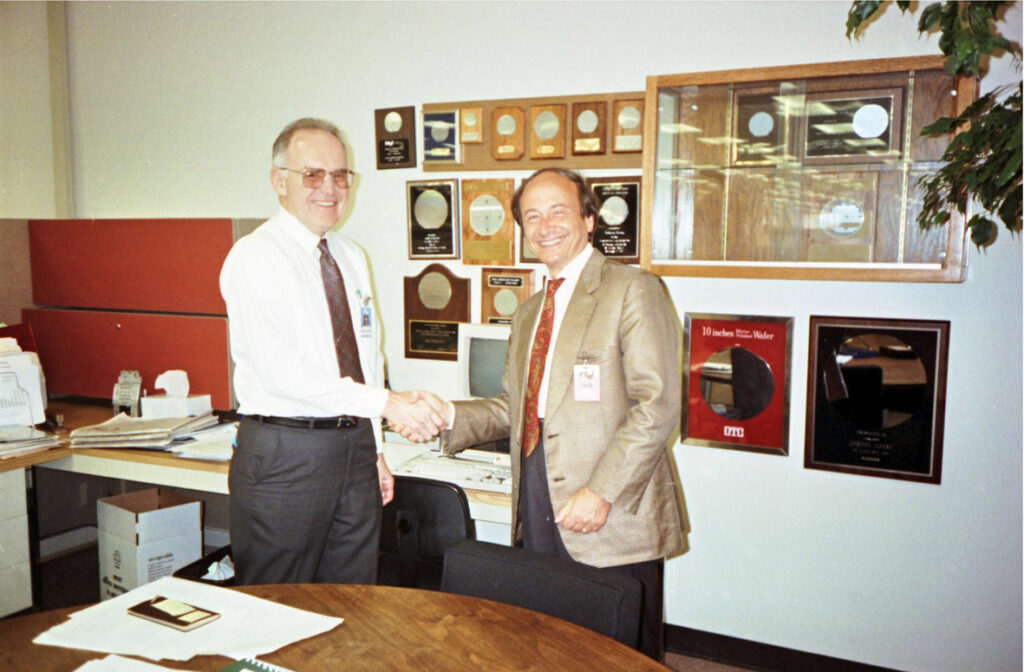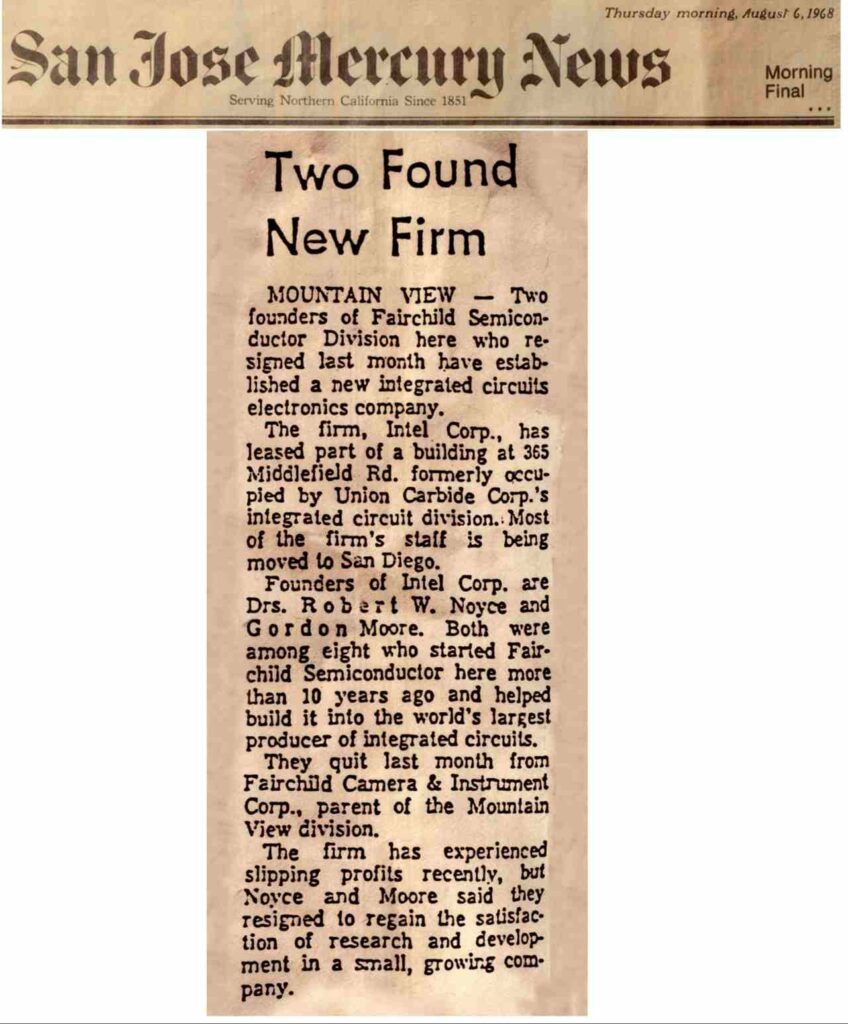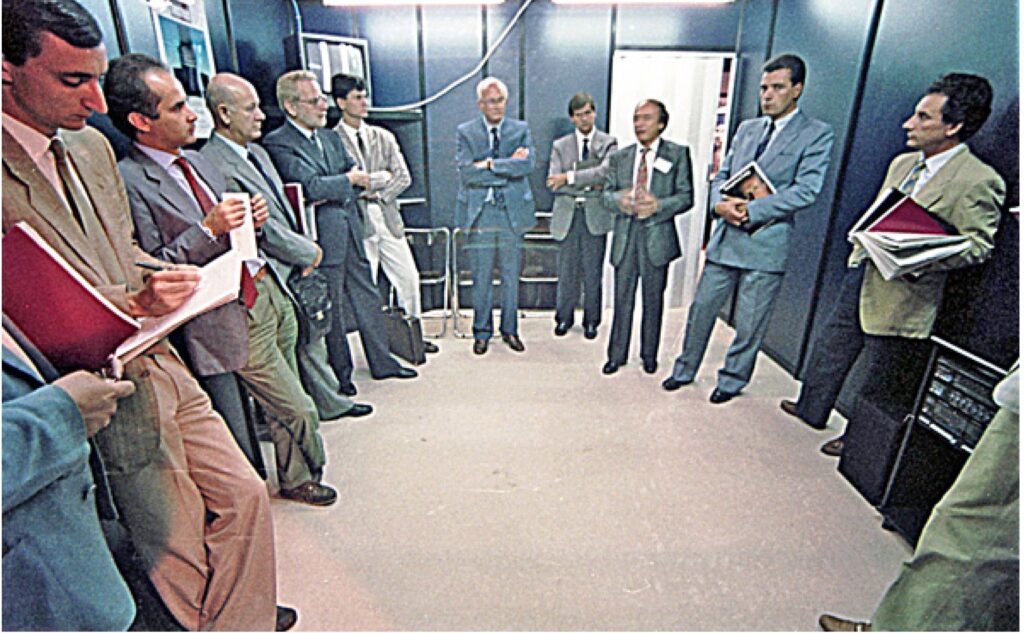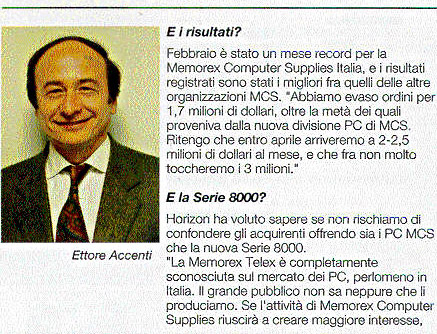
Carlo Denza : 25 November 2025 09:54
With exclusive photographs and unpublished documents: the extraordinary story of the Italian engineer who collaborated with Gordon Moore and Alan Sugar, bringing Intel to Italy and building the first tech empire with Amstrad.
1987. Milan. An entrepreneur receives a phone call from London: create an Italian branch from scratch in three months. With August in between, there were only two months left. Impossible.
December 1987: 20 billion lire in turnover. 1989: 120 billion. 2,000 stores built from scratch. From 15 to 60 employees.
This is the story of Ettore Accenti , Intel’s first representative in Europe, the man who brought personal computers into Italian homes by collaborating with giants such as Gordon Moore, the father of the famous Law , Robert Noyce , Mike Markkula , Steve Jobs , Alan Sugar , and Microsoft . A masterclass in tech strategy ante litteram.

August 1969. In a Milanese office near the Duomo, Accenti was leafing through American specialized magazines looking for new products to add to the catalog of Eledra 3S , a company he had founded three years earlier while he was still a student at the Polytechnic. Among the pages, a short article caught his attention: the birth of Intel Corp. (Integrated Electronics) in Mountain View, California.

Intel’s products were interesting, but the real selling point was the names of the founders: Gordon Moore and Robert Noyce . The two were already living legends in the semiconductor world, having graduated from Shockley Semiconductor Laboratory to found Fairchild Semiconductor . For Accenti, those names meant a lot.
The decision was immediate. Together with Dr. Eva, her collaborator and future Mrs. Accenti, she wrote a letter of interest to Intel. Meanwhile, she thoroughly studied the chips the Californian company was marketing: the i3101 bipolar memory (64-bit static RAM). Months passed without a response. Then, an unexpected phone call.

Jens Paulsen , Intel’s European manager, proposed a meeting in Milan. Accenti showed up with a folder of notes on each Intel chip: Paulsen was impressed by the meticulous preparation. The result? A three-month trial collaboration that made Accenti the first Intel representative in Europe.
Although Intel was only selling two static random access memory (SRAM) chips at the time, the i3101 and i1101 , companies such as IME, Olivetti, and Siemens began requesting them as early as 1969. Within twenty years, Eledra 3S became the largest Italian electronics distributor.
After Eledra 3S’s lifecycle ended with its separation from Olivetti, in 1987 Accenti received a call from Alan Sugar , British entrepreneur and founder of Amstrad . The challenge: create the Italian subsidiary in three months. With August unusable, there were two months left to build: offices, warehouse, information system, employees, and sales network.
May 27, 1987. Accenti flew to Brentwood and met with Malcolm Miller , Jim Rice , and Ken Ashcroft . When asked when to launch the business, he replied, “September 1st.” The two crucial exhibitions, SIM ( Milan ‘s music and electronics fair ) on September 3rd and SMAU on September 16th, were just around the corner : they would be the ideal launching pad. A wry smile on the faces of the English managers betrayed their disbelief.
But Accenti didn’t think like the others. For the office, he discarded the conventional 400 square meters near Linate and chose 2,000 square meters on Via Riccione: 30% cheaper and with room to grow. For logistics, he converted the Cariplo warehouses in Pavia, originally used for cheese and milk, into computer storage.
But the real game was played out on the sales network . Rejected by Expert , Accenti had an intuition: he turned to the Singer network, 500 sales outlets spread throughout Italy that until then had sold sewing machines . The agreement was revolutionary: samples on consignment, payment on sales, full-page advertising in newspapers with their addresses.
The next day, the entire range was presented at the convention at Villa Serbelloni in Bellagio. Dr. Eva still remembers the skeptical expressions of the Singer dealers when they saw the first PCs: ” We’ll never sell these gadgets ,” one of them whispered. The results were astonishing: between September and December 1987, Amstrad Italia generated a turnover of 20 billion lire . The impossible had become possible.
September 3, 1987. The inauguration of the SIM in Milan. Among the journalists was a young Marco Travaglio from Il Giornale. The next day, the Corriere della Sera ran the headline: ” The Computer Aiazzone Has Arrived in Italy .” That headline was worth more than any advertising campaign.
For print and TV, Accenti signed a contract with Alberto Vitali , creator of the 1984-85 Commodore 64 campaign. Vitali revealed the formula: ” Maximum number of releases at minimum cost .” No rigid planning, just daily advertising to whoever offered the best deals. The media competed with each other.

The numbers spoke clearly. In 1988, Nielsen , a leading market research institute, crowned the British company first in the sector with a list price of 15.208 billion (IBM second with 9.555 billion, Olivetti third with 9.165 billion). The actual spending? A fifth. The effect multiplier: two to three times the competition.
For technical support, Accenti bet on Filippo Bua , a home appliance repair center manager with no computer experience. His winning argument: ” Repairing a PC is easier than a television. Diagnostic programs, card replacement .” Bua accepted and transformed his organization into PE92 , Italy’s leading IT support company.
For specialized publishing, Accenti brought in Jacopo Castelfranchi . He unblocked an old GBC contract by buying back unsold stock, transforming Castelfranchi into a strategic ally. With the publishing house JCE, he launched Amstrad Magazine : over 20,000 copies on newsstands, numbers that many technical magazines could only dream of.
Late 1980s. The most strategic collaboration arrived: the one with Microsoft . Amstrad was about to launch new PCs with Intel 286 and 386 processors. Accenti’s intuition was simple but effective: to market them bundled with Microsoft Excel 3 , which was due out shortly thereafter. The software was already completed and the only thing waiting for the official documentation to be completed before the launch.
He requested exclusivity for a few months, but Microsoft Italy’s response was a blunt “impossible.” Accenti didn’t give up and countered with an alternative: no exclusivity, but a supply so massive that it would allow for a joint Microsoft-Amstrad advertising campaign. The result? The Italian subsidiary became the first in the world to surpass, with Excel, the historic Lotus 1-2-3 , the dominant spreadsheet program of the 1980s.
Success with Excel paved the way for other partnerships: ESA Software and TC Sistema. Advanced resellers demanded management software and complete solutions.
January 20, 1990. On the Maurizio Costanzo Show , Italy’s most popular television show. Costanzo jokingly suggested naming a computer Ignazio. Accenti didn’t waste a second: ” Want to see me actually launch an Ignazio computer with Amstrad? ” The audience applauded. The brand had become a mass phenomenon.
The numbers were unmistakable: from 20 billion in the final four months of 1987, to 90 billion in 1988, to 120 billion in 1989. In three years, Accenti grew a market from zero to 112 billion lire, with a total turnover of over 220 billion . From 15 to over 60 employees. From zero to over 2,000 stores. An unprecedented rise.

August 1990. Amstrad began to change the policies that had created its Italian success: advertising delegated to centralized European agencies, overturned sales plans, discounts imposed from above.
Accenti reacted. He devoted an entire week in August to preparing a 10-page report for Alan Sugar. Sugar’s response: ” There’s some common sense in your report .” After a convention in Rome at the Hotel Villa Pamphili with dealers and Sugar himself, everything seemed resolved. But the absurd requests began again.
Accenti called a special board meeting in Brentwood for September 21st. It was a bold move: never before had a subsidiary convened a board meeting at the parent company. The plan was approved. But after a few days, the pressure began again.
Accenti sent a harsh fax to Sugar. Amstrad’s founder flew to Milan’s office on Via Riccione. The confrontation was direct. Sugar said he had to choose between Accenti and his English managers. Accenti included: his battles had been interpreted as a desire to oust someone.
His response: ” No choice necessary. I resign .” They signed an agreement on a piece of paper. October 1990. Accenti left the office with a strange feeling: relief mixed with disbelief. Three intense years concluded in ten minutes.
The decline was rapid. Accenti’s successors lacked managerial experience. They disrupted the virtuous cycle: they delegated advertising, granted volume discounts, and extended payment terms. Retailers lost confidence. Revenue plummeted. Credit problems escalated.
On December 11, 1990, Amstrad Plc issued a statement: “Amstrad Plc thanks engineer Ettore Accenti for having brought Amstrad Spa’s turnover from zero to 112 billion lire.”

As Amstrad sank, Accenti received a call from Memorex-Telex : $2 billion in revenue, 10,000 employees, IBM’s main competitor.
December 1990, Paris. Lunch with Jean-Claude Zanolli , executive vice president. The question: ” What do you think? ” Accents: ” It takes two days to discuss it with Eva .” Zanolli: ” Two days is too long, tell me yes or no before you finish your coffee .” They negotiated the location: Lugano. A stone’s throw from Milan.
Starting in January 1991, Accenti took over responsibility for Europe, South America, the Middle East, Africa, and the Pacific. On January 18, 1991, three days after its inception, the first war in Iraq broke out. All American managers were asked not to fly. Accenti took off for Venezuela on January 20. An international adventure that would last three years.

Today, more than twenty years after retiring in Lugano, Accenti continues to build the future: on October 30, 2025, he inaugurated the Silicon Valley Library at SUPSI , Startup Garage, donating original books and documents to inspire new generations of entrepreneurs.
When asked if it would be possible to replicate an operation like Amstrad’s today, Accenti reflects lucidly: ” The answer is no, not in the same way. Times change, products change, the tools must be completely different. But massive and penetrating marketing operations are still possible. Apple has sold over a billion iPhones worldwide at very high prices .”
Accenti’s story demonstrates that success in tech doesn’t require unlimited capital or revolutionary technologies. It requires obsessive preparation, lateral thinking, rapid execution, and strategic partnerships. In 2025, the tools are different, but the principles remain the same: from zero to $120 billion in three years isn’t magic. It’s strategy.
An Italian story of vision, courage, and the ability to continually reinvent itself.
We would like to thank Ettore Accenti for opening his archives to author Carlo Denza and the editorial staff of RedHotCyber , sharing historical memories, documents, and exclusive images from the Silicon Valley Library.
Follow us on Google News to receive daily updates on cybersecurity. Contact us if you would like to report news, insights or content for publication.
 Carlo Denza
Carlo Denza